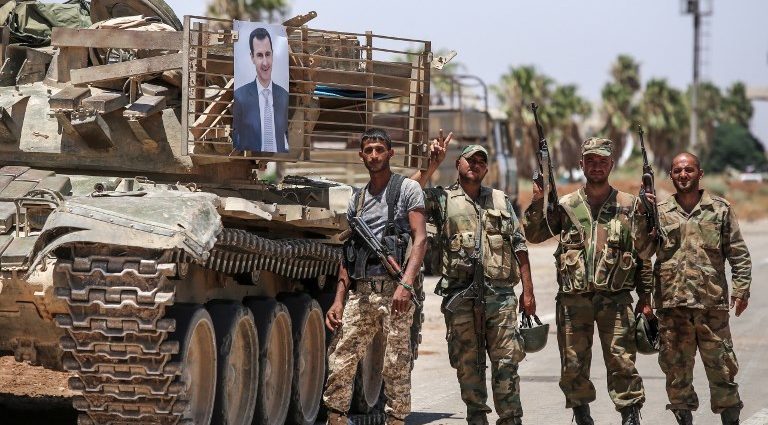
On July 18, an assassination in the southwestern Syrian province of Daraa claimed the life of a member of the armed forces. Unlike the politically motivated incidents that plague the region, this attack stands out because the victim was primarily known for his involvement in the trafficking and distribution of narcotics.
Two similar attacks last month suggest that the killing wasn’t an isolated event. Indeed, there has been a surge in drug-related assassinations since the beginning of the year, introducing a new dimension to the ongoing violence in the province.
Silence from the involved parties complicates matters, making it difficult to determine responsibility. Conversations with local sources reveal a growing determination within the community – rather than the government – to challenge the drug trade.
And yet these targeted killings alone won’t be sufficient to eradicate the drug-related activities that saturate Syria’s south.
Daraa has seen a staggering 22 assassination attempts since the start of the year, according to local media reports. The first killing was in February, followed by two similar shootings in March. April marked a dark turn, with nine targeted attacks. Except for the recent strikes, the distribution of the remaining killings is unclear.
The attacks vary in method, ranging from targeting dealers on the move to forcefully entering residences and shooting at close range.
The assassinations haven’t only targeted civilians involved in the drug trade but also pro-government militia members engaged in illicit activities.
In interviews, local sources told me that targets have included fighters affiliated with various state military bodies and security agencies, including military, air, and state intelligence, and the Fourth Armored Division, which is led by Maher al-Assad, the president’s brother.
Fayez al-Radi, a militia commander associated with military intelligence and actively involved in drug trafficking, is among the most prominent figures to have been killed.
In at least one incident, a drug-related facility linked to Iran-backed militias was hit. Reportedly used for manufacturing and coordinating drug smuggling operations to Jordan and the Arab Gulf region, the site near Zizon village was struck by three RPG shells this year.
Local sources link these assassinations to growing public frustration with the drug trade. Residents are increasingly concerned about the safety of their families, fearing the high level of criminal activities and violence driven by addiction. Stories of easily accessible drugs, on the streets and even in schools, are frequently cited.
Inaction by Assad regime
Public anger is further fueled by the lack of official efforts to end the illicit activity. Despite many promises, the government hasn’t taken significant action to curb the spread of drugs, and prominent drug networks even enjoy protection from the state’s security and military bodies.
This cooperation, driven by financial and political motivation, remains intact despite neighboring Arab states making a crackdown on the drug trade a key condition of recent efforts to restore relations with President Bashar al-Assad’s regime.
At the height of the civil war, Syria became the world’s biggest producer of the amphetamine Captagon, bringing in billions of dollars in revenue. The pills flooded into Jordan and Saudi Arabia, and these states now want to see the flow of drugs snuffed out at source.
Daraa province, with its long border with Jordan, is a hotbed for Captagon production and smuggling.
Local Syrian power brokers, criticized for not doing enough to stop drug dealers from plying their wares, began acting this spring. Notably, the Eighth Brigade, composed primarily of former opposition fighters now operating under the government’s umbrella, launched an anti-drug campaign in Daraa’s eastern region in March.
But the crackdown quickly lost momentum. Some speculate pressure from the government forced the Eighth Brigade to holster its weapons. Others, citing the lack of action against prominent drug dealers like Imad Zuraiq, a militia leader affiliated with military intelligence, viewed the campaign as a poorly disguised pretext to settle scores with leaders or militia groups.
The authorities’ apparent tolerance of the drug trade has prompted locals to take matters into their own hands. Many in Daraa have access to arms and the skills to use them, especially those who were involved in military activities in the past.
Yet while the theory of locals taking the initiative makes sense for some of the killings, it doesn’t explain all of them.
Rival drug dealers, particularly those who previously clashed over influence or territory, might be involved. Former opposition armed groups currently affiliated with the government could also be behind the killings. Hit-and-run operations, rather than direct confrontation, would be one way to address local concerns without alienating the regime.
Finally, the involvement of Islamic State (ISIS) and, to a lesser extent, Hayat Tahrir al-Sham affiliates, cannot be ruled out.
The power and profit afforded by Daraa’s drug trade have made dealers seemingly impervious to danger. Armed and confident, they continue their illicit trade, unfazed by the risks involved.
While the recent assassinations may look like extrajudicial attempts to eradicate a societal scourge, the reality is more complicated and only adds another layer of instability in an already violent region.
Follow this writer on Twitter @HaidHaid22.

